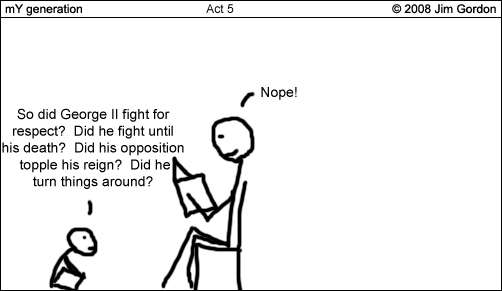|
|
|
Archive for October, 2008
Thursday, October 16th, 2008
A great consultant I do work for (rewriting stuff for his clients) asked me if he needed a better bio and I said it would help. Here’s what he wrote back,
Yep, I would like a better bio also. Something like, “Presidents call him for advice. Business tycoons hang on his every word. Movers and shakers get moved and shaken when he speaks…” Unfortunately, my bio should read, “He is a pretty good guy. He has helped a few people. Good father, good husband. Maybe he can help you a little.”
Actually I like the second part better.
Every consultant has the ear of presidents and business tycoons hanging on their words. If you don’t believe me, just read their resumes.
Yeah, right.
Consultants are valuable, especially in tough economic times, but beware the ones who sprinkle the conversation with mover names and talk at length about all the shakin’ going on.
Especially when checking references. (You do check consultant references, don’t you?)
Look instead for the people whose references talk about what they did as opposed to who they know; how they helped and what they did.
And it doesn’t hurt if they’re pretty good people.
Image credit
Posted in Business info, Communication, Culture, Motivation | No Comments »
Wednesday, October 15th, 2008
For a great collection of links to other b5 blogs who took part in Blog Action Day 2008 check out Buzz Networker. Enjoy!
Your comments—priceless
Don’t miss a post, subscribe via RSS or EMAIL
Posted in Announcements, Politics | 2 Comments »
Wednesday, October 15th, 2008

A Wordless Wednesday look at global poverty—no place is immune, no person is safe.
   


The future is NOW.
Open your eyes, get off your tail, and DO something.
Stop waiting for a leader—BE ONE!
Don’t miss my other WW: the death of our future
Your comments—priceless
Don’t miss a post, subscribe via RSS or EMAIL
Image credits From left to right England, France, Japan, United States, Thailand, India
Posted in Ethics, Politics, Wordless Wednesday | 5 Comments »
Wednesday, October 15th, 2008


If we wait for them to fix it nothing will happen.

Only WE can change it.
Don’t miss my other WW: leadership fools means poverty rules
Image credits: first image, second image
Posted in Leadership, Politics, Wordless Wednesday | 2 Comments »
Tuesday, October 14th, 2008
This is part 3 in an ongoing discussion.
 Documentation Documentation
The documentation of evolution is DNA, the amazing double helix that contains the entire genetic code for each individual.
Contrary to most business documentation, evolution does not store its genetic documentation in printed “white notebooks” that sit on the shelf gathering dust. On a daily operational basis, each cell uses RNA to copy sections of the DNA. Then RNA reads these strands to execute cell functions.
Operating processes (documentation) are the DNA of a company. To replicate its operation from day-to-day a business must have complete documentation.
- How does your business document its operation?
- How does any individual employee know what to do in any specific situation?
Thorough documentation is critical. But remember that evolution uses its documentation every day to drive the operation of the cells.
- How accessible is your documentation?
- Can an employee find it quickly?
- Is the operational sequence embedded in the process itself?
Historically it has been difficult to make documentation easily accessible, and even more difficult to embed processes in the organization. But with the advent of the internet and intranets, help files, business process software, and the entire operational process has come to resemble evolution more closely.
In fact, only online documentation and processes can ever function as well as evolution.
Documentation Checkup
- Is all of your business documentation available online?
- Is it accessible through context-sensitive help?
- Are all of your business processes documented?
- Are your business processes embedded in the everyday operational processes that your employees use to do their work?
- Are your business rules externalized?
- Do your explicit business rules drive your business processes?
Training
Evolution has developed an almost foolproof process to train new cells. Every time a new cell is created, it receives a complete set of DNA documentation . When a cell splits the DNA double helix unzips down the center and each cell receives one of the exact original strands of DNA. Training for the new cell is 100%, with a complete set of original documentation. Note that the cell does not learn the DNA documentation of the processes of life. The DNA simply is the processes. The definition of the processes is intrinsic to the processes themselves.
In the same way, a business needs to replicate itself very carefully. A new employee must be trained thoroughly. Ideally the process description and documentation is not separated from the business processes themselves. The definition and description are embedded in the processes. The closest description is a context-sensitive help file in a completely transparent process.
Most businesses have some sort of training for new employees. Thorough training should present a holistic view of the operation, from the business goals to very specific operation of particular business processes that the employee will do. Further, training should include error checking and correction. Simple online, self-paced, computer-based training (CBT) is a good place to start, but only a start. An old Chinese proverb provides a direction for comprehensive training.
I hear and I forget.
I see and I remember.
I do and I understand.
Training starts with reading the documentation and testing recall. Then it extends to simulation and participation in the actual business processes. Like learning to swim, the employee flounders in the deep end of the simulation until, suddenly, the light bulb goes on. Only simulation and participation in the actual processes can provide the direct feedback that leads to knowledge, mastery, and effective reproduction of the process.
Training Checkup
- Does your business provide complete online, self-paced CBT?
- Does your training include testing and exception handling?
- Does your training include simulations and the real business processes?
- How do you keep records of employee training?
- How often do you retest and retrain your employees?
- When your business processes change, how do you retrain and recertify your employees?
Error Correction—Handling Exceptions
Exceptions happen and some exceptions have serious consequences. Sometimes errors occur in transcribing DNA and almost every transcription error is bad, often fatal to the organism. Evolution assumes that DNA will have transcription errors, so it has developed error checkers that travel the DNA chain specifically to find and fix these transcription errors.
Evolution also assumes that errors will occur in cell operation, so it has developed a number of methods to fix operational errors. Evolution evidently is a believer in Murphy’s Law—Whatever can go wrong, will go wrong. One of evolution’s favorite error correction methods is terminal obsolescence—death. It’s a little drastic, but works well for evolution. All of evolution’s experiments come with expiration dates.
Like evolution, a business must develop a number of mechanisms to detect exceptions and correct errors. Our focus is on exceptions in existing operational processes—”events outside the boundaries of normal operations,” as opposed to true anomalies—novel events which occur rarely and unconnected to existing processes.
Computerized processes automatically identify simple exceptions such as data entry errors, e.g., identifying and rejecting letters entered into a numeric data field such as age. But most exceptions are more complicated.
An exception to a time-based event may have a number of responses conditional upon the degree of the exception. When an insurance policy expires and the payment check arrives late, the response may depend upon how late the check arrived, with penalties increasing in proportion to the tardiness.
Just as operational processes are simply expressions of business rules, the first few levels of exception handling must be controlled by business rules, with automatic detection requiring no human judgment to determine the response.
For processes that manage hundreds to millions of separate events, exception handling must meet four criteria:
- Immediate identification – because the cost of the exception and the response increases dramatically as the exception remains unaddressed.
- Immediate response – even if the consequences are delayed, the response must be quick.
- Appropriate consequences – “Let the punishment fit the crime.” Choose a response that resolves the exception with minimal side effects.
- Recorded for evaluation – trends often start as exceptions. Log the exceptions so the causes can be found and fixed.
The long-term response to exceptions is to eliminate them. In manufacturing processes a method called “statistical process control” uses operational trends to identify root causes and to resolve them. Example: An automatic lathe trims metal wires to exactly 1 cm diameter. The acceptable tolerance is 0.01 cm. The measurement of the bars after trimming shows upward trend, from 1.002 cm last week to 1.004 cm this week. The wires are still within the specification, but the statistical upward trend indicates problems ahead. A maintenance check on the machine shows the cutting bit has worn down. Once the bit is replaced, the upward trend stops.
This is a simple physical example, but the same concept applies to other operational processes.
Automatic processes make easy examples, but most of our processes are semi-automatic, with people doing the “semi” and people causing most of the exceptions.
Various tests indicate that people achieve success rates of 90-98% for many things, attaining success rates above 98% only in very specific situations designed to support peak performance. So when our business processes include people we must expect exception rates of 2-10%.
The root causes for exceptions generated by people fall into four categories:
Documentation – is the task adequately documented?
Training – is the person trained to do the task?
Task match – Is the task reasonably suited to the person doing it? Obvious examples are physical limitations—requiring acute eyesight or hearing. Less obvious examples are tasks requiring math skills, language skills, or external knowledge.
Personal issues – Does the person have some issues (health, family, etc.) that are affecting performance? How do you identify these situations, and how does your organization handle them?
Exception Handling Checkup
- How does you business plan for exceptions?
- How well does your business define and identify exceptions?
- What is the frequency and cost of each exception?
- Does your business have automatic business rules for handling frequent exceptions?
- How quickly does your business identify each exception?
- How quickly does your business respond to each exception?
- Does your business log exceptions and track exception trends?
- Do you know which of your processes are semi-automatic vs. fully automatic?
- How does your organization handle employee personal issues?
Redundancy through Distribution (Cross-training and Project Teams)
Evolution builds in redundancy almost everywhere, at almost every level. DNA itself has two strands in a double-helix. Evolution prefers bilateral symmetry—two eyes, two ears, legs, arms. Bilateral symmetry provides many benefits, including back-ups.
Evolution also uses cross-training. As an extreme example, some adult reptiles, amphibians and even fish can change sex when needed. Stem cells can change functions. The same gene that controls the number of spines in the fins on a fish also controls the number of fingers on a hand. Enable that gene for a short time to get three fingers on a frog hand. Enable it a little longer to get four fingers and a thumb.
Evolution also uses cross-functional teams. Genes perform different functions when enabled by different proteins at different
times. Genes even respond to relative position in the body—front/back, left/right, top/bottom. The same gene expresses different actions depending upon the proteins that indicate its position within the body.
Evolution uses clusters of genes to drive the development of specific elements in an organism. The overused example—the eye—is the result of a number of genes working together. Frequently genes activate other genes in a long Rube Goldberg sequence of genes and proteins to construct a specific organ. Each gene may be a member of several clusters, each cluster working together for a short time, to accomplish a specific purpose.
In business we use project teams, or cross-functional teams, in much the same way. To install a new software system the project leader may bring together a collection of experts in the software application, business process engineering, subject matter experts, and of course the users themselves. If we look at the entire business as a series of projects, is it possible to operate the business predominantly with a collection of cross-functional teams on a routine basis?
At this point a reader may be considering some obvious objections. First, all this cross-training and project operation must create redundancy and increased overhead with all the associated additional costs. As any good cost accountant knows, there are many ways to analyze cost. Cross-functional project teams typically add value to a business on a longer time horizon and on a larger scale.
Example: Installation of a new software system. The project implementation team has specific goals: improve the internal adoption rate, make the system easier and better to use, and reduce the operational errors it generates.
Each of these goals is an annuity that generates an ongoing economic return over time. So the value of the project implementation team must be calculated over time.
Another common objection to a cross-functional team is the specific expertise required for certain jobs. Can an accounts receivable collections clerk be trained to do software development? Do we really want our lead sales person to learn the intricacies of cost-accounting? Some job pairs simply do not fit into a cross-training model, but many others are amenable to cross-training.
Businesses face considerably different demands for reconfiguration as they grow and change. So the capabilities for reconfiguration must be different. Obviously an accounts receivable collections clerk cannot be retrained to do software development overnight.
Cross-training requires the elimination of many cherished prejudices in order to take advantage of all cross-training opportunities within the business.
Cross-Training Checkup
- To cross-train, you need good training capability. How well does your business train employees?
- What cross-training programs do you have in place?
- How often does your business use project teams?
- Does each project team have a charter, a set of objectives, and an expiration date?
- Are the project team members chosen from different functional areas?
Why so much talk about operations? What about sales, new products, and business leadership?
For some readers this series of posts may feel like a long walk through the weeds of operations. Some sales people left the room awhile ago, to go make customer calls.
However, evolution’s first job is replication and, just like evolution, a successful business must know how to replicate its past success.
Processes, training, documentation, exception handling, project teams and cross-functional training, are the tools by which a business “remembers” what it did yesterday and recreates that success today. In short, operations and execution keep the business going every day.
Do not give up on evolution yet as a model for business. As we consider how evolution uses variation and selection, you will find plenty of opportunity to use your creativity, enthusiasm, insight, and other uniquely human skills.
I’ll return next week for the first of two posts on variation.
Posted in Business info, Communication, Personal Growth | Comments Off on Evolution Of Business: The 4 Tools Of Replication
Tuesday, October 14th, 2008
 It is the rare leader who leads beyond what is expected of him.Those who do are often labeled as unfit to lead and dismissed. It is the rare leader who leads beyond what is expected of him.Those who do are often labeled as unfit to lead and dismissed.
There are not that many examples of such rare leaders. General MacArthur was certainly one. He stood up to President Truman, who was quite happy to play at war in Korea without winning it, which cost many thousands of lives for no real gain. Gen. MacArthur’s dismissal by the President was a terrible blow to his honorable record of service throughout World War II, an embarrassment to the Army he commanded, and the beginning of an approach to conflict that has plagued us ever since. But his dismissal was also completely rational, because he was not working to expectations.
Leaders, who wish to keep their jobs, work to satisfy expectations.
Understanding this is critical to our understanding of what has recently happened in the financial and mortgage markets.
The key here is understanding that leaders lead only with the support of their constituency (i.e. stockholders or boards of directors in the case of corporate leaders or voters in the case of politicians). A leader cannot get away with major strategic direction that his constituency does not approve, such as running full-bore into selling sub-prime mortgages. This is not a matter of a few rogue leaders who ran ahead of their organizations without oversight or accountability. Every head of every organization caught with their mortgages down was in that position with the full knowledge and support of his constituency. That includes Wall Street, banks, and both GSEs (Fannie Mae and Freddie Mac).
Even the criminal actions of overstating balance sheets in order to gain the huge bonuses being offered had to be done with the knowledge and approval of a constituency. For instance, Franklin Raines of Fannie Mae could not have gotten away with overstating his balance sheet repeatedly to gain the $90 million he earned over 6 years (as the organization was actually failing) without both his board and the Congressional oversight committee assigned to watch his actions approving of it. In fact, in 2004, when Armando Falcon, the chief regulator who “blew the whistle” on these shenanigans, went before the Congressional oversight committee, he was all but tarred and feathered for his efforts. No one seemed interested in hearing about anything untoward, because the objective of increasing mortgages to low-income families was being addressed. End of subject.
Corporate executives also are being whipped for the “outrageous” sums of money they earn, primarily as a reward for pushing stock prices ever higher. As I have written many times, the tactics they use to accomplish this are more often than not the death-knoll for the long-term success of the organization, but that doesn’t stop the board of directors and stockholders from applauding their efforts.
The problem comes down to, “Who really cares before the damage starts to show?” Top executives are not stupid. Neither are politicians (the few years I worked with Washington politicians proved to me that almost all believe they have the best interests of their constituency in mind). They know exactly where their support comes from and what that constituency wants from them. Despite all the worries about sub-prime mortgages that were voiced over most of the past decade, no one really cared.
Why? Because expectations were being met. The deceit was in hiding the truth from the constituency. What made the sub-prime fiasco possible was the fact that risk was being “diluted.” Every time a package of mortgages was sold to investors, the real hidden risks were lost in the mass. That effectively removed the effect of what would have been the most vocal constituency: those who would have spoken up by keeping their checkbooks closed had they known the real risk.
The only constituency that really knew what was going on in most cases was the one gaining from it.
The same thing is going on in corporations across the country. Decisions about how companies are being run are coming from the wrong constituency. The expectations are being driven by boards of directors and stockholders, who care little about the long-term health of the company as long as short-term gains are good enough to increase their personal portfolios.
So, what is the answer? Can we expect companies to survive and do the job for which they were created, i.e. job and wealth creation for those who invest their time and money into it, when persons with no long-term interest are defining the expectations for corporate executives? Can we expect government-overseen organizations or programs to have positive long-term effects, if those defining expectations are only interested in narrow outcomes that can create far greater damage but that provide personal gain for them (even if it is only in terms of pandering to the base desires of their constituencies)?
Leaders lead to expectations. Isn’t it time we started setting expectations that don’t just “use” an organization for personal success and instead start expecting long-term success that builds the organization creating that success?
We are being asked to take a greater personal role in addressing climate change. Can’t we also take a greater role in demanding corporate responsibility? If not, we may be witnessing the end of the independently-run corporate model in America.
We are delegating far too many decisions that affect us as long as things seem to be “going right” (no matter how obvious the risks are), and then expecting someone else to make things right. Isn’t now the time for the real constituency to stand up and make its voice known?
We can do it through our investing. We can do it through our voting and regular conversations with our political representatives. We can do it in through an unwillingness to let others speak for us, while we sit back and demand that everything go perfectly right for us.
How would you address this without giving even more control to a constituency that would drive the wrong expectations?
Your comments—priceless
Don’t miss a post, subscribe via RSS or EMAIL
Posted in About Leadership, Ethics, Leadership Choice, Leadership Turn Odd Bits, Leading Factors, Leading Stupidities, management, Politics, Wes Ball, What Leaders DO | 2 Comments »
Monday, October 13th, 2008
Stephen Covey says, “We simply assume that the way we see things is the way they really are or the way they should be. And our attitudes and behaviors grow out of these assumptions.” And we, the people, did assume. And we, the people, did assume.
We, the people, assumed that the visions presented by the leaders on and off Wall Street were true.
We, the people, assumed that all those experts were correct when they lauded the Wall Street crowd.
We trusted them, even though it’s not the first time that the Wizards of Wall Street broke our hearts—and our economy.
Last year when I wrote about CEO pay I said, “If little girls are made of ‘sugar and spice and everything nice’ and little boys are made of ‘snakes and snails, and puppy dog tails’, then these CEOs are made of ego and greed and the skill to mislead.”
We, the people, have a short attention span and we’re lazy.
It’s so much easier to listen to the experts and then blame them when things don’t work out. Less painful than looking in the mirror and taking responsibility for our own contributions as passive followers.
But why should we? Our leaders take no responsibility.
President Bush pats us on the head, says he knows things are difficult, but doesn’t take responsibility.
Alan Greenspan, a great believer in deregulation, still thinks derivatives are good and puts the blame on the leaders who, he says, got greedy.
Whereas five years ago Warren Buffett called them “financial weapons of mass destruction, carrying dangers that, while now latent, are potentially lethal.”
But it’s so much easier, not to meniton comfortable, to listen to the experts who say everything is fine than to the experts sounding a warning.
Our leaders may have led us down the garden path, but we, the people, were happy to follow—being careful to keep our rose-colored glasses intact and firmly in place.
Your comments—priceless
Don’t miss a post, subscribe via RSS or EMAIL
Image credit
Posted in About Leadership, Ethics, Followers, Leadership Choice, management, Politics, What Leaders DON'T | No Comments »
Monday, October 13th, 2008
 Dwight D. Eisenhower said, “You do not lead by hitting people over the head – that’s assault, not leadership” or managership. Dwight D. Eisenhower said, “You do not lead by hitting people over the head – that’s assault, not leadership” or managership.
But there’s a kernel of truth in the old story of the mule and the farmer.
Farmer 1 bought farmer 2’s mule because it was a very hard worker. When the mule refused to work, farmer 1 called farmer 2 and asked what to do. Farmer 2 came over, grabbed a 2×4 and whacked the mule over the head with it. The mule immediately started to work. ‘When you want the mule to work,’ farmer 2 said, ‘the first thing you need to do is get its attention.’
Actually, they’re both right.
You do need to get your people’s attention, but hitting them with a 2×4 is more likely to get them on the phone to a recruiter than to make them pay attention.
However, hitting them with honest, open communications that gives them the whole story along with all the information needed to do their job efficiently and then getting out of the way, while staying available to clear whatever obstacles appear, will get not only their attention, but also their engagement.
Image credit
Posted in Business info, Communication, Culture, Motivation, Retention | No Comments »
Sunday, October 12th, 2008
 What a difference a day—or in this case a couple of years—makes.Here are quotes by and about four of the leaders whose vision helped lead us to our present situation. These are the same guys lauded by universities, the media, leadership pundits and themselves just short time ago. What a difference a day—or in this case a couple of years—makes.Here are quotes by and about four of the leaders whose vision helped lead us to our present situation. These are the same guys lauded by universities, the media, leadership pundits and themselves just short time ago.
“Bad behavior is aberrational…never is a big word…the chances of [the company] getting into trouble again are virtually nil.”— Chuck Prince Citigroup Dec. 16, 2005 at the annual Citigroup Investor Day,
“We’re sticking with [Angelo] Mozilo because he has built a top-notch organization with strong risk controls that could emerge even stronger from the current subprime meltdown.” Barron’s, April 18, 2007
“The vision is to hire terrific people who will be the next generation of leaders and the people who will take this firm to the next level.” Richard Fuld, Knowledge@Wharton, January 10, 2007 (link includes his five qualities for leadership)
Your comments—priceless
Don’t miss a post, subscribe via RSS or EMAIL
Image credit
Posted in About Leadership, Leaders Who DON'T, Leadership Quotes, Leading Stupidities, management, Quotable Quotes, What Leaders DON'T | 1 Comment »
Sunday, October 12th, 2008
So ends the saga of George II as it parallels Shakespeare’s Richard III—not with a bang but a whimper. See all mY generation posts here.

Posted in mY generation, Politics | No Comments »
|
 Subscribe to
Subscribe to
MAPping Company Success
About Miki 
Clarify your exec summary, website, etc.
Have a quick question or just want to chat? Feel free to write or call me at 360.335.8054
The 12 Ingredients of a Fillable Req
CheatSheet for InterviewERS
CheatSheet for InterviewEEs™
Give your mind a rest. Here are 4 quick ways to get rid of kinks, break a logjam or juice your creativity!
Creative mousing
Bubblewrap!
Animal innovation
Brain teaser
The latest disaster is here at home; donate to the East Coast recovery efforts now!
Text REDCROSS to 90999 to make a $10 donation or call 00.733.2767. $10 really really does make a difference and you'll never miss it.
And always donate what you can whenever you can
The following accept cash and in-kind donations: Doctors Without Borders, UNICEF, Red Cross, World Food Program, Save the Children
*/
?>About Miki
About KG
Clarify your exec summary, website, marketing collateral, etc.
Have a question or just want to chat @ no cost? Feel free to write
Download useful assistance now.
Entrepreneurs face difficulties that are hard for most people to imagine, let alone understand. You can find anonymous help and connections that do understand at 7 cups of tea.
Crises never end.
$10 really does make a difference and you’ll never miss it,
while $10 a month has exponential power.
Always donate what you can whenever you can.
The following accept cash and in-kind donations:
|















 It is the rare leader who leads beyond what is expected of him.Those who do are often labeled as unfit to lead and dismissed.
It is the rare leader who leads beyond what is expected of him.Those who do are often labeled as unfit to lead and dismissed. And we, the people, did assume.
And we, the people, did assume. Dwight D. Eisenhower said, “You do not lead by hitting people over the head – that’s assault, not leadership” or managership.
Dwight D. Eisenhower said, “You do not lead by hitting people over the head – that’s assault, not leadership” or managership. What a difference a day—or in this case a couple of years—makes.Here are quotes by and about four of the leaders whose vision helped lead us to our present situation. These are the same guys lauded by universities, the media, leadership pundits and themselves just short time ago.
What a difference a day—or in this case a couple of years—makes.Here are quotes by and about four of the leaders whose vision helped lead us to our present situation. These are the same guys lauded by universities, the media, leadership pundits and themselves just short time ago.

